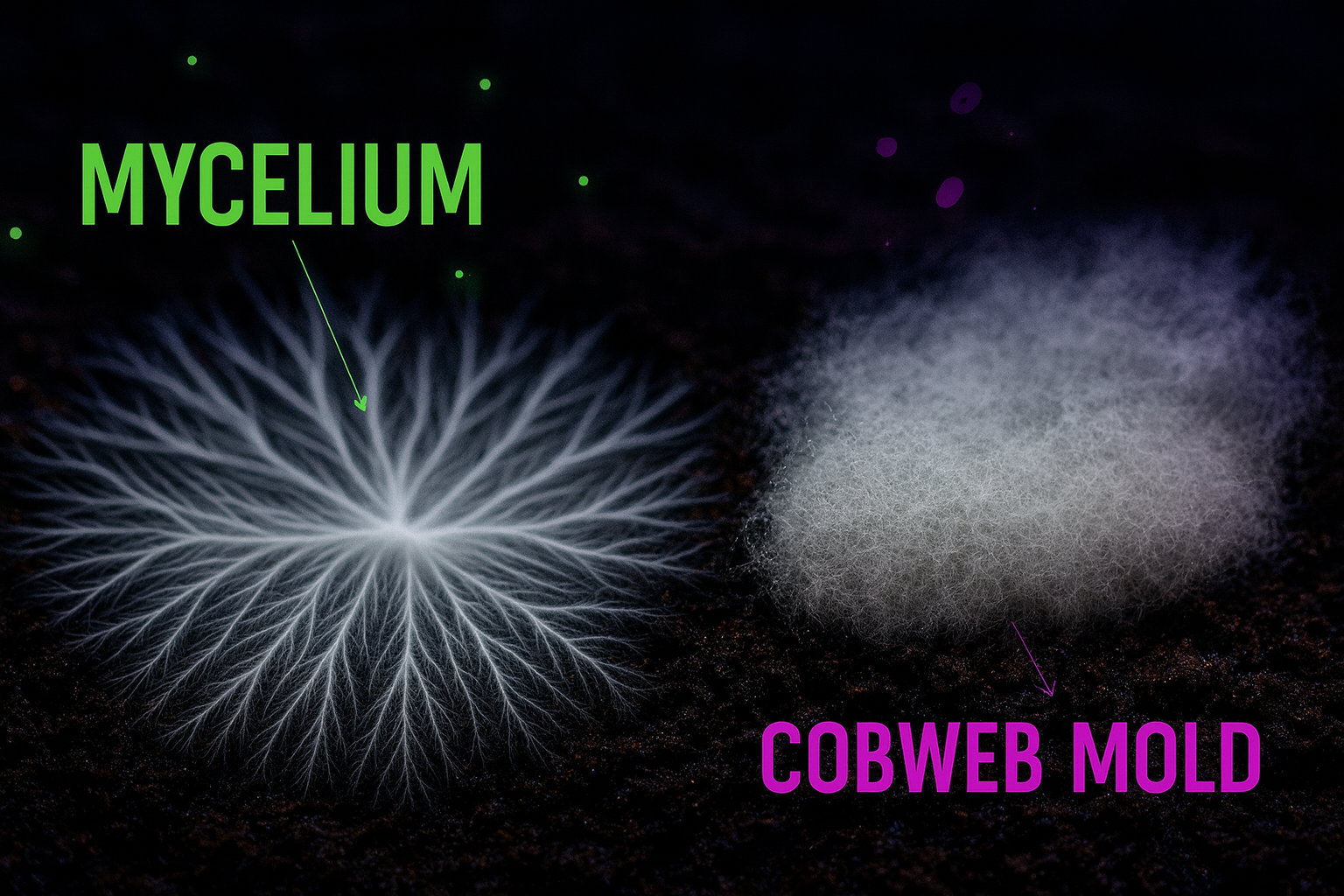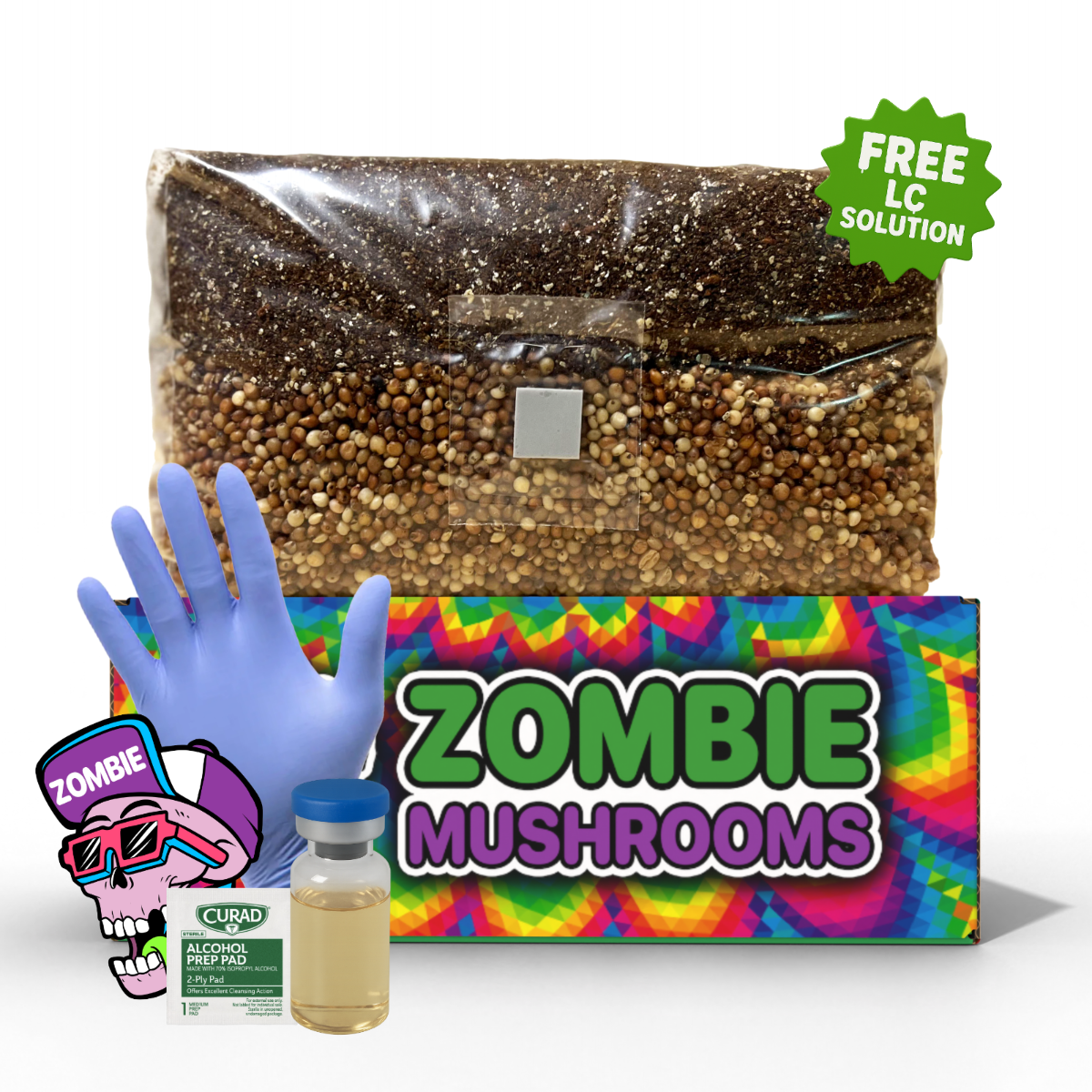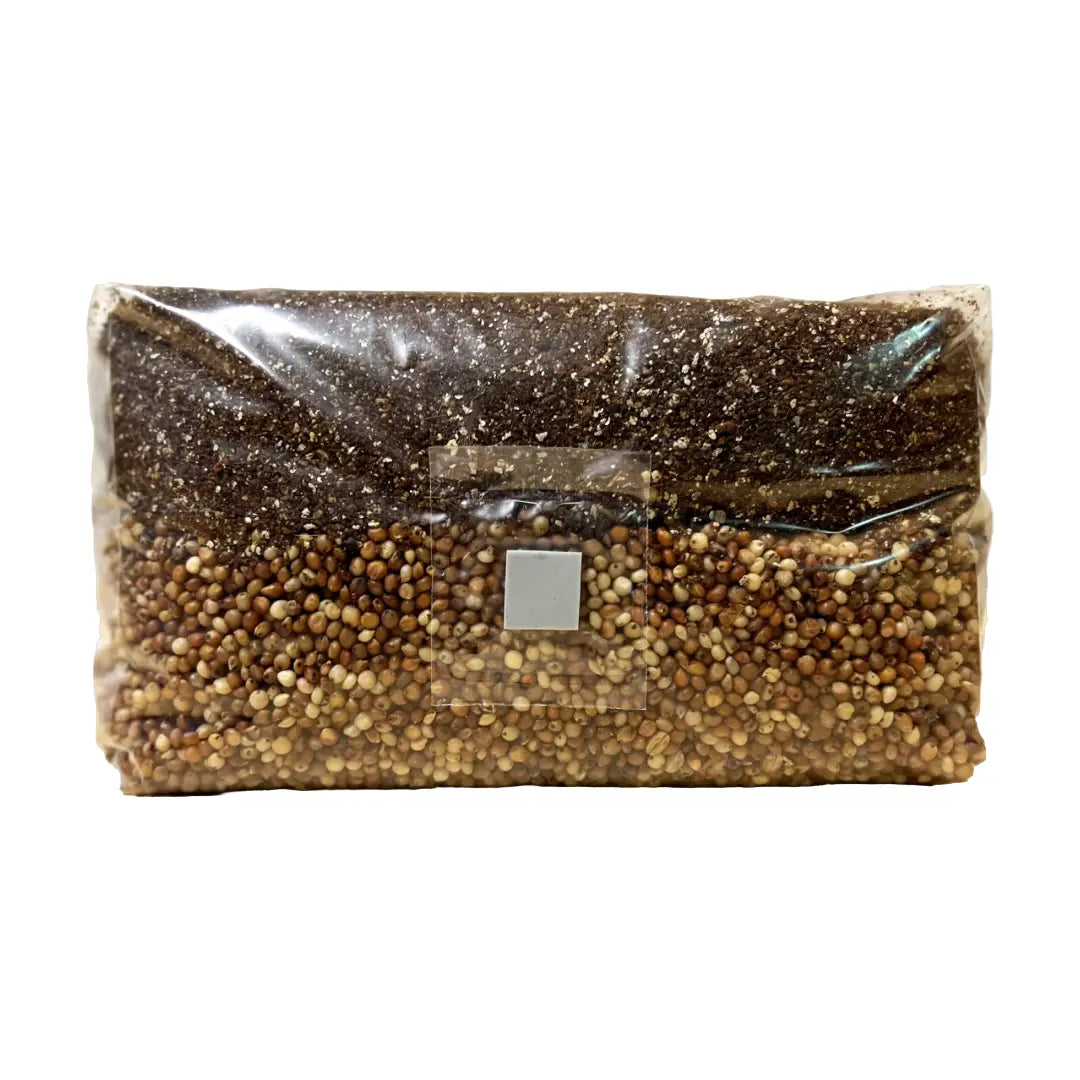⬇️ Prefer to listen instead? ⬇️

- ⚠️ Cobweb mold can overtake a mushroom substrate in just 24–48 hours under poor ventilation and high humidity.
- 🕵️ Confusing cobweb mold with mycelium is common due to their similar initial appearance, especially among beginner growers.
- 💨 Good airflow and humidity control are important for stopping cobweb mold from growing.
- 💧 3% hydrogen peroxide can effectively eliminate cobweb mold without damaging healthy mycelium.
- 🧪 Identifying contamination early by smell and visual cues helps recover or save a grow operation.
Mushroom growing is rewarding, but it comes with challenges. The main one is contamination. For beginners using grow kits, cobweb mold is a common and confusing problem. It looks a lot like healthy mycelium. But if you let it grow, it can ruin your whole crop. Learning to tell the two apart is one of the most important things you can learn early in mushroom growing. Our beginner-friendly grow bags provide a clean, sterile environment that makes learning easier and contamination less likely—helping you focus on growing healthy mushrooms, not fighting mold.

What Is Cobweb Mold (Hypomyces spp.)?
Cobweb mold, known scientifically as Hypomyces, is a fast-spreading fungus. It takes over mushroom growing material quickly. It grows well in the warm, humid places made for mushrooms to fruit. This makes it a common problem for indoor growers.
Many molds look dark or green. But cobweb mold starts thin, gray-white, and wispy. It looks a lot like young, healthy mycelium. It usually shows up when mushrooms are fruiting, or late in the substrate's colonization. This is often just when growers think they are getting close to success.
Cobweb mold spores float in the air and grow easily. They land on exposed, nutrient-rich growing material. They quickly grow on surfaces when conditions are right. Bad air flow, high humidity, wet tools, and not being clean enough help these spores grow. Cobweb mold is not thought to be bad for humans. But if you do not treat it, it can ruin your mushroom crop. It can even infect mushroom parts.
Once cobweb mold starts, it usually takes only one to two days to form a clear film over your growing material or in your grow space. This kind of mushroom contamination can cause large commercial setups, and even small home grows, to lose whole batches (Stamets, 2000).

What Does Cobweb Mold Look Like?
One main problem with cobweb mold is that it looks like young mycelium. This makes many growers ignore it or think it is normal growth. But there are several key traits that can help you tell cobweb mold from healthy mycelium:
- Color: Cobweb mold looks dull gray-white. This shade might look like young mycelium, but it is not bright.
- Texture: It feels soft, like cotton candy. Think of a light spider web over the growing material. It is airy, with no firmness or going down deep into the material.
- Growth Pattern: It shows up in scattered, uneven spots. These often appear overnight where there is less air flow and high moisture. They tend to stay on top of the growing material instead of going into it.
- Response to Gravity: Cobweb mold often seems to “collapse” or sag. It does not grow in a focused or dense way like mycelium.
Bad outbreaks may also get a slimy layer underneath. Sometimes, slight discoloration or wet rot can appear under the moldy surface.

What Does Healthy Mycelium Look Like?
In contrast, healthy mushroom mycelium grows with purpose and structure. Knowing what strong mycelium looks like helps you see problems. It also helps you understand how healthy your crop is. Good traits include:
- Color: It is bright white and might shine a little under grow lights. This differs a bit between types of mushrooms. But a bright, snow-like color is usually a good sign.
- Texture: At first, it can be fluffy. But as it spreads, it forms thicker, denser strands called rhizomorphs.
- Growth Pattern: It is even and steady. Mycelium starts where it was added and spreads out evenly from that spot. It grows deep, going through the whole material like tiny roots.
- Structure: It sticks firmly to and grows into the growing material. This helps break it down and take in nutrients (Sánchez, 2010).
Even mycelium that looks fuzzy at first should show structured growth in a few days. If you are growing a type like Pleurotus ostreatus (oyster mushrooms), expect mycelium to grow fast. It will grow both on and under the surface of the material.
Be careful but feel sure. Healthy growth rarely changes its look or spot overnight, unless the growing conditions change a lot.

Key Differences At-a-Glance: Cobweb Mold vs Mycelium
| Feature | Cobweb Mold | Mycelium |
|---|---|---|
| Color | Gray-white, dull | Bright white, sometimes glistening |
| Texture | Wispy, loose, superficial | Dense, ropey, embedded |
| Growth Speed | Very fast (12–48 hours) | Moderately paced over days or weeks |
| Growth Pattern | Spreads on top only | Grows into and throughout substrate |
| Smell | Musty, foul, sometimes sweet | Earthy, clean, neutral |
| Structural Traits | Collapses easily | Firm, rootlike network (rhizomorphic) |
Checking often and using tools like this chart can stop bad contamination. This lets you act fast.
When Does Cobweb Mold Usually Show Up?
Cobweb mold grows easily. It usually shows up during two important times in the growing cycle:
- Towards the End of Colonization: When mycelium is almost fully grown, its loose form and almost used up nutrients leave exposed areas that have not been colonized. These areas are ready for invasion.
- During Fruiting: After you add a fruiting chamber, the higher humidity and possibly still air greatly raise the risk of cobweb mold.
In good conditions (high humidity, stale air, open growing material), it can show up in just 24–36 hours, even overnight (Stamets, 2000). This sudden appearance often surprises new growers. They might think it is fast mycelial growth.

Why Do Growers Confuse the Two So Often?
New growers, especially those using automatic or pre-built mushroom grow kits, find the early fluffy mycelium exciting and confusing. Young mycelium's first cottony look can seem like the airy look of cobweb mold.
Growing conditions make this confusion worse:
- High Humidity Chambers: This makes mycelium grow fluffy instead of in thick, rope-like strands.
- Low Airflow: Mycelium reacts by growing more in the air, floating over the growing material.
- Lack of Experience: Without knowing what normal growth looks like or having pictures to compare, any new growth might be misunderstood.
Learning how to spot mycelium—like watching how it acts over 24 hours—can help you tell healthy growth from contamination. Healthy mycelium will not suddenly appear in patches or get darker over time.

Preventing Cobweb Mold Before It Starts
A clean and well-kept space is, without a doubt, your best way to fight any mushroom contamination. Here is how to stop cobweb mold before it starts:
-
Sterile Technique:
- Always disinfect gloves, hands, and tools before substrate contact.
- Work inside a still air box or laminar flow hood during inoculation.
-
Air Exchange (FAE):
- Put in small air holes or air out the space 4–5 times a day.
- Still air helps mold grow.
-
Humidity Control:
- Keep humidity between 80–95%. But do not let puddles or water drops form.
- Use a hygrometer to be exact.
- Substrate Prep:
Doing these routines makes a growing space that helps mushrooms. But it stops fungi like Hypomyces from finding a place to grow (Sánchez, 2010).

How to Treat Cobweb Mold if You Find It
Finding cobweb mold does not always mean you lose your crop. Acting fast can sometimes save your grow:
-
Isolate the Infection:
- Immediately remove trays or jars showing mold symptoms.
- Seal them in a plastic bag before moving to prevent further spore spread.
- Hydrogen Peroxide Mist:
- Lower Humidity:
- Increase FAE:
-
Throw Out if Spreading:
- If mold comes back after treatment or goes deep into the main growing material, throw out the whole batch.
- Clean with bleach, vinegar, or strong disinfectants.
Do not ignore other signs either. If the grow smells bad or looks different overnight, check it right away.

Should You Use Grow Kits or DIY Substrate?
Picking between mushroom grow kits or making your own setup depends on how much experience you have and how much you want to control cleanliness. Let's look at both:
-
Grow Kits:
- Best for beginners.
- Already clean and ready to use.
- Less chance of getting dirty from not cleaning well.
- Companies like Zombie Mushrooms think about air flow and moisture. This is key for not getting cobweb mold.
- DIY Substrate:
Beginners should start simple. Learning how to spot mycelium and follow cleanliness rules is easier in forgiving settings.

Can Contaminated Mushroom Kits Be Saved?
Yes, if the conditions are right. When you act matters most here. You can often treat and stop early cobweb mold that is only in one spot. This can be done without losing much of your crop.
What helps you know if you can save it:
- Extent of Contamination: Small patches = salvageable; large outbreaks = risky.
- Growing Material Type: Thicker materials might hide mold inside. These are harder to treat.
- Environment: If spores are still spreading due to poor HVAC, recontamination is likely.
If cobweb mold returns after treatment or begins appearing across multiple trays, consider wiping your setup clean and starting fresh (O’Brien et al., 2005).

Let Your Nose Help: The Mold vs Mycelium Smell Test
Experienced cultivators trust their noses as much as their eyes. Smell often gives away contamination before it’s visible.
- Cobweb Mold: Smells sour, damp, or slightly sweet, like wet clothes left out too long. This often gives you a bad feeling.
- Healthy Mycelium: Fresh forest floor—neutral to pleasant, earthy.
If your grow area begins to consistently smell “off,” it’s a red flag—even before symptoms visibly appear.

Long-Term Tips: Avoiding Contamination in the Future
Being steady and careful are key to growing mushrooms well. Keep things clean over time with these habits:
- Sanitize all surfaces with 70% isopropyl alcohol before and after sessions.
- Wear gloves and a face mask during inoculation or harvesting.
- Label jars/trays with date and strain for trace visibility.
- Store spores and tools in airtight, sterile containers.
- Avoid growing near kitchens or bathrooms—high-spore zones.
Simple precautions often mean the difference between a successful flush and a contaminated disappointment.
Don’t Panic—But Definitely Learn From It
Cobweb mold is frustrating, but it is a common part of learning to grow. It might ruin a batch. But it teaches important lessons about staying clean, balancing the environment, and spotting mycelium. With every spoiled tray, you become a better, more skilled grower.
Getting stuck or unsure? Reach out to the pros at Zombie Mushrooms—we’re always ready to help you troubleshoot, identify contaminants, or simply improve your next grow.
References
- Stamets, P. (2000). Growing gourmet and medicinal mushrooms (3rd ed.). Ten Speed Press.
- O’Brien, H. E., Parrent, J. L., Jackson, J. A., Moncalvo, J. M., & Vilgalys, R. (2005). Fungal community analysis by large-scale sequencing of environmental samples. Proceedings of the National Academy of Sciences, 102(5), 14683–14688.
- Sánchez, C. (2010). Cultivation of Pleurotus ostreatus and other edible mushrooms. Applied Microbiology and Biotechnology, 85(5), 1321–1337.



